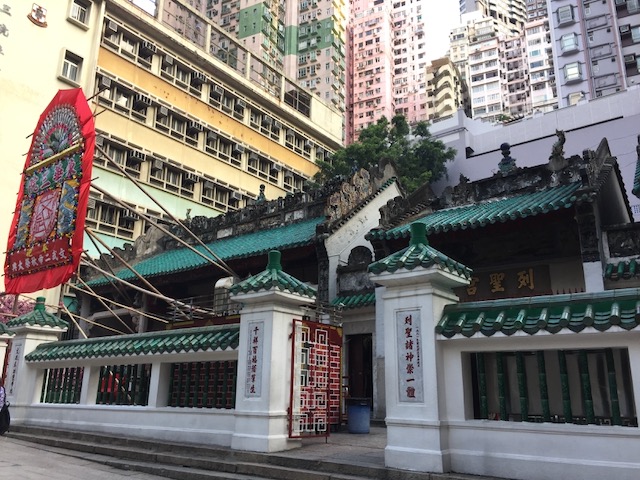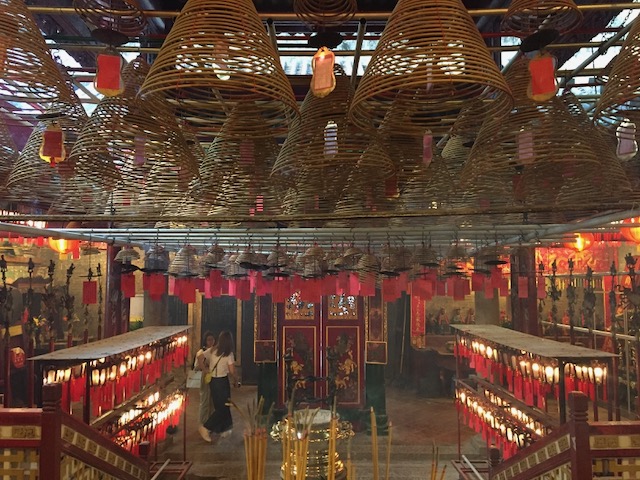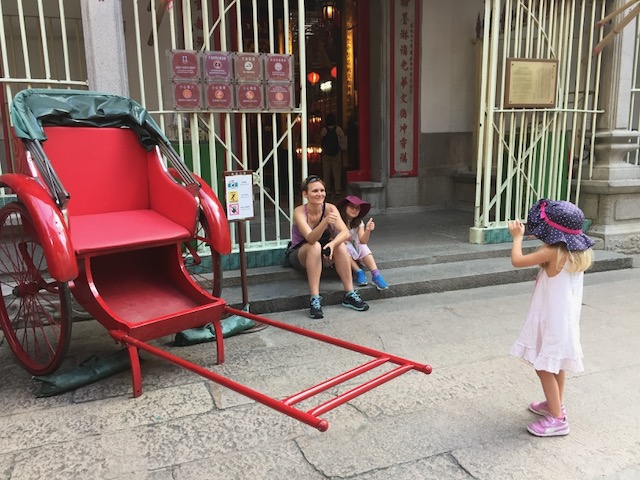October 16 to 21, 2019

Population: 7 million
Located south of China, 2000 km from Beijing
After one month in Mainland China and before going to Vietnam, we stayed in Hong Kong for 5 days. From Guangzhou, we took a high-speed train and arrived in only one hour. Too easy... Customs and passport control on both sides of the border and here we are.
The brand new train station in Hong Kong is located in Kowloon and we could get to our rental within a 15-minute walk. The apartment is very small, which was expected considering the limited space and the real estate price here. We spent the first night alone, Laurent my best friend from Toulouse, would join us the next day and spend some time with us in Vietnam.
The urban zone of Hong Kong consists of the island of Hong Kong and Kowloon peninsula on the north side. The New Territories, which represent 80% of Hong Kong surface are essentially the mass of land located north of Kowloon and some islands. It is a more natural region, less populated with small fishermen villages and mountains.
As usual, the first day, we walked around to discover our neighborhood. We were very well located in the heart of Kowloon, close to shops, malls, restaurants (they are everywhere anyway!) and subway. Victoria Harbour (the bay between Kowloon and the Hong Kong island) is a 20-minute walk from our place.
This place contrasts a lot with Mainland China.
The city is modern, multi-cultural, there is a lot of expats and it was quite enjoyable not being the center of attention (especially for the girls). There is also a lot more money and everything is more expensive than in China, which forces us to pay a little more attention to our budget.
Almost everything is written both in English and Cantonese (and most people speak both languages), clearly everything will be easier here. As Coralie told me, Hong Kong feels a little bit like China with subtitles...
Bubble of History: Like I already told in the Guangzhou post, Hong Kong was won by the British after the opium wars (1839-1842 and 1856-1860), then enlarged in 1898 (by incorporating what we call the New Territories). That year, after a deal with China, a 99-year lease was granted to the UK. In 1997, Hong Kong was retroceded to China but a special status has been created for Hong Kong (and Macao) under the principle "One country, two systems" which allows Hong Kong to keep its judiciary system (Common Law), its currency (Hong Kong dollar), its political system (multi-party), sports teams, immigration law, internet domain, phone code and driving rules (left side). This system should stay in place until 2047, 50 years after the retrocession. (Source Lonely Planet and Wikipedia).
Urban Hong Kong
So, the first evening, we just walked around in Kowloon with no real objectives, and we spent some time in the poshy malls. We went by a Toys'R Us and the girls stayed a while there looking at the toys and playing. We owed them that, they only have 2 dolls, 2 little lego box and some cards to play and have fun on the trip.
A break for the girls
Then, we went to Victoria Harbour, from where there is a nice view on Hong Kong Island. We finished our evening in a nice Italian restaurant. After one month of Chinese diet, it was nice to eat pizzas and spaghettis (and enjoy a good red wine)...

Hong Kong Island by night
The next day, we went to Hong Kong Island and roamed the streets, checked the street markets (located on a hill), and Man Mo (buddhist) Temple. We took it easy that day and did nothing special. Fun moment of the day, we took a tramway, the girls and especially Coralie loved it. 😃
Man Mo Temple
Double-deck tramway
That evening, Laurent met us at the apparemment. Afterwards, we went to meet his 2 cousins Luca and Mathieu and their respectives girlfriends Charlotte and Zhe An. We spent the evening in a nice cantonese restaurant. They have been living here for many years (Charlotte is a local), so they shared tips for our stay and our future travels in South-East Asia.

Dinner with Laurent's family
The third day, we returned to Hong Kong Island to see Hong Kong Park. Its highlight is the birds' enclosure: visitors go in to see the birds. Then, we took the cable car up to Victoria Peak and it was awesome! The slope is very steep and the way up is impressive. From the peak, we had a nice view of the bay and the city. We were lucky as it was a very sunny day and the sky was clear (which is not always the case, the area gets foggy). We walked back down to the city, which was not easy because of the slope. After 1h, we finally arrived, exhausted. After such an effort, we deserved a drink and tried the IFC rooftop, amongst skyscrapers, offering a view over the Victoria bay and Kowloon.
Colorful birds in the park
Our way up with the cable car

View from Victoria Peak
The Giant Buddha and Tai O village
On the fourth day, we went out of town to see the giant Buddha. We took the subway to the terminus station and from there a cable car took us up the hill (yes, tramway, cable cars, we love all those fun transportation modes 😉). The ride was 25 to 30 minute long and gave us nice views over the airport traffic flying in and out. The Buddha is magnificent, Naema is a fan of the statues that surround him.
From what I understood, this statue was built in the '90s by China. At that time, the lease to the UK was about to end and China (communist and secular) wanted to show they would respect religious freedom.
In the cable car and views

The Giant Buddha
After this visit, we took a bus to go to a fishing village Tai O, where we spent the end of the afternoon.
This little "nature" escape with the mountains and coastal village were a real contrast with urban Hong Kong. After a few days spent only in big towns (including Guangzhou), it was appreciated.

Tai O village
The protests and thoughts about the political issues
(Disclaimer: this is my personal view, it might be incomplete and you may disagree with it)
As everybody knows, Hong Kong has been subject to weekly protests for a few months now. It started with a new law for prisoners' extradition to China. But behind that, there is a legitimate fear for Hongkongers to see China gaining more and more importance in their life, and probably trying to pull in the date of special status (initially scheduled for 2047). The response from the government (and the cancellation of the law) took so much time that now the movement is being more radical and seems to reach a dead end.
After one month in China, especially in this special time of the 70th PRC founding anniversary, we could understand the fears of the Hongkongers.
China is not a democracy. It is a country where people are watched all the time, political opponents are jailed and there is no respect of personal liberty. Security cameras are installed everywhere, in offices, streets, crossroads and even restaurant kitchens (one of the restaurant we went to was proud to say they don’t watch their employees). Passports are controlled in every touristic attraction, bags are checked in every train and subway station (ok, maybe this could be understood for security purposes). Internet access is limited, most of the Western sites and applications are blocked (Google, Gmail, Facebook, Instagram, WhatsApp, YouTube, most of the European and US news websites, even this blog editor). To avoid this, one should install a VPN (for non-geeks, it is a program-installed computer and smartphone that acts as a firewall and creates a virtual location so that the authorities cannot see it), and even that was an issue around October 1st, VPN themselves were blocked…
The Chinese have only access to what the government let them see, which means official information, or propaganda and created a parallel system, equivalent to what we know: social networks, videos website, which let them control what can be broadcasted. And more importantly, everybody uses the WeChat app. At first this looks like a messenger service but it is also a payment app (like ApplePay or AndroidPay) and as the government has access to it, it can be used to follow and watch people and even grade them (as good citizens, good payers).
Another way of watching people is policemen dressed as civilians. In 2 occasions, we have seen individuals getting arrested in the open. Both times, the cops were not wearing uniforms and the scenes were quite shocking. The first time was in Beijing, a group of 4 men were crossing a touristy place holding another man by each arm and leg, even hand-covering his mouth to avoid attracting attention. The second time was in Guangzhou, a man was handcuffed, held between 2 big guys and taken to a white car. He was not trying to attract attention but looked beaten down. Why were these individuals arrested and was it fair? It is hard to say but the sight of these 2 scenes sent shivers down our spines.
Back to Hong Kong, the youth has well understood that China wants to install the same process there. Their strength (and the issue for China) is that Hongkongers, unlike the Chinese, know what freedom and democracy mean and are. It is not that easy to take that away from them now.
Our last day in Hong Kong was a Sunday, protests day. Our apartment was located right in the protests area that day, around the Tsim Sha Tsui police station in Kowloon. Of course, we stayed put the whole afternoon, but we could hear everything. Luca, Laurent’s cousin was even closer (he lives in front of the police station) and gave us regular updates. Protesters were walking with masks (to avoid being recognized by their employers among other reasons), policemen would throw tear gas from the rooftops. Blue water was also used, to help identify protesters.
At the end of the day, almost everything went back to normal and we could even walk to the night market nearby and eat at a restaurant.
This experience left a mark on us and we will follow the evolution of the conflict, hoping for the best.
Protests in Hong Kong
Salah




































































Comments